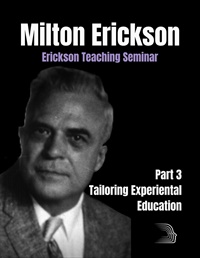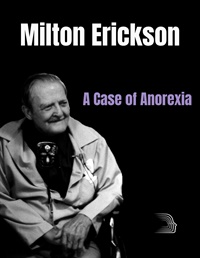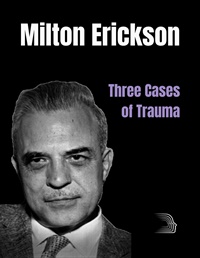Erickson Materials
- Average Rating:
- Not yet rated
- Topic Areas:
- Milton Erickson | Ericksonian Hypnosis and Therapy Techniques | Hypnosis | Destabilization | Dissociation | Seeding
- Bundle:
- Spanish Erickson Video Bundle
- Categories:
- Erickson Materials | Erickson Streaming Video Collection | Milton H. Erickson Collections | Spanish | World Languages
- Faculty:
- Milton H. Erickson, MD | Jeffrey Zeig, PhD
- Course Levels:
- Master Degree or Higher in Health-Related Field
- Duration:
- 1 Hour 11 Minutes
- Format:
- Audio and Video
- Original Program Date:
- May 07, 2020
- Short Description:
- En la primera parte de Sembrando un tema - Un seminario de enseñanza con Milton Erickson, serás testigo de cómo Erickson planta una semilla sin problemas, conecta los puntos, desarrolla un tema y cierra el ciclo en un período de clase. Aprenderá cómo Erickson condujo la disociación a través del tempo, el contenido y el tono de sus palabras.
- Price:
- $29.95 - Base Price
- Average Rating:
- Not yet rated
- Topic Areas:
- Milton Erickson | Arm Levitation | Ericksonian Hypnosis and Therapy Techniques | Hypnosis | Trance | Utilization | Hypnotic Phenomena
- Bundle:
- Spanish Erickson Video Bundle
- Categories:
- Erickson Materials | Erickson Streaming Video Collection | Milton H. Erickson Collections | Spanish | World Languages
- Faculty:
- Milton H. Erickson, MD | Jeffrey Zeig, PhD
- Course Levels:
- Master Degree or Higher in Health-Related Field
- Duration:
- 1 Hour 19 Minutes
- Format:
- Audio and Video
- Original Program Date:
- May 07, 2020
- Short Description:
- En la segunda parte de un seminario de enseñanza con Milton Erickson, será testigo de cómo Erickson observó y utilizó cuidadosamente los comportamientos no verbales de un estudiante para desarrollar una experiencia de trance utilizando la levitación del brazo mientras interactúa simultáneamente para enseñar a otros estudiantes. Verá cómo el Dr. Erickson utilizó estratégicamente los fenómenos hipnóticos.
- Price:
- $29.95 - Base Price
Credit available - Click Here for more information
- Average Rating:
- Not yet rated
- Topic Areas:
- Tailoring | Ericksonian Hypnosis and Therapy Techniques | Experiential Therapy | Milton Erickson | Trance | Unconscious Processes
- Categories:
- Erickson Materials | Erickson Streaming Video Collection | Milton H. Erickson Collections
- Faculty:
- Milton H. Erickson, MD | Jeffrey Zeig, PhD
- Course Levels:
- Master Degree or Higher in Health-Related Field
- Duration:
- 1 hour
- Format:
- Audio and Video
- Original Program Date:
- May 07, 2020
- Short Description:
- In part three of a Teaching Seminar with Milton Erickson, we continue the development of trance experience in the primary subject. You will encounter the experiential teaching method for which Erickson was renowned.
- Price:
- $29.95 - Base Price
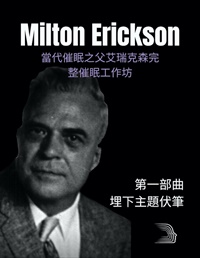
- Average Rating:
- Not yet rated
- Topic Areas:
- Milton Erickson
- Categories:
- Erickson Materials | Erickson Streaming Video Collection | Milton H. Erickson Collections | World Languages | Chinese
- Faculty:
- Milton H. Erickson, MD | Jeffrey Zeig, PhD
- Course Levels:
- Master Degree or Higher in Health-Related Field
- Duration:
- 1 Hour 12 Minutes
- Format:
- Audio and Video
- Original Program Date:
- May 07, 2020
- Short Description:
- 在艾瑞克森催眠工作坊的第一天,艾瑞克森示範如何在學生心裡種下種子。你會看到艾瑞克森埋下伏筆,把點串連起來,發展一個主題,最後做個完美收尾。你也會學習到艾瑞克森如何透過說話節奏,內容,以及說話音調來創造催眠解離。
- Price:
- $29.99 - Base Price
Tags: Erickson Translations
Credit available - Click Here for more information
- Average Rating:
- Not yet rated
- Topic Areas:
- Anorexia | Eating Disorders | Milton Erickson | Ericksonian Hypnosis and Therapy Techniques | Utilization | Hypnosis
- Categories:
- Erickson Materials | Erickson Streaming Video Collection | Milton H. Erickson Collections | Online Continuing Education
- Faculty:
- Milton H. Erickson, MD | Jeffrey Zeig, PhD
- Course Levels:
- Master Degree or Higher in Health-Related Field
- Duration:
- 1 hour
- Format:
- Audio and Video
- Original Program Date:
- Apr 27, 2020
- Short Description:
- In this video, you will see Erickson’s unusual way of treating anorexia. Erickson described himself as a person who has an iron fist, but a velvet glove. He knew when it was right to be firm, to be disciplined, and even to be assertive in work with a client. Dr. Jeffrey Zeig provides insightful commentary on this historic Erickson clip.
- Price:
- $29.95 - Base Price

- Average Rating:
- Not yet rated
- Topic Areas:
- Milton Erickson | Advanced Techniques of Hypnosis & Therapy
- Categories:
- Italian | Advanced Techniques of Hypnosis & Therapy | Erickson Materials | World Languages
- Faculty:
- Milton H. Erickson, MD | Jeffrey Zeig, PhD
- Duration:
- 2h 26m
- Format:
- Audio and Video
- Original Program Date:
- Sep 24, 2019
- Short Description:
- Commento di Jeffrey K. Zeig, Ph.D. Questa sessione ipnoterapeutica ha avuto luogo nel 1978 e, decenni dopo, è altrettanto potente e coinvolgente. Migliorare l'esperienza di apprendimento dello spettatore è la discussione del Dr. Zeig sugli elementi alla base dei metodi di Erickson: il modello di istruzione ARE; l'arte della comunicazione parallela; utilizzo mirato; e l'uso dell'implicazione. Il repertorio fluido di Erickson, tratto dal pensiero sistematico, include l'uso di aneddoti, comunicazione simbolica e semina strategica. La ricerca di soluzioni, basate sulla promozione di associazioni costruttive e pensieri e sentimenti flessibili, è un'area di particolare interesse e in cui Erickson era particolarmente elegante.
- Price:
- $59.00 - Base Price
Tags: Erickson Translations
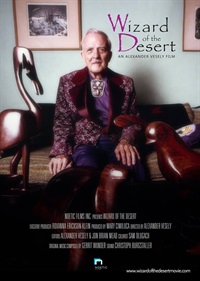
- Average Rating:
- Not yet rated
- Topic Areas:
- Not Available
- Categories:
- Biographical Video | Erickson Materials
- Faculty:
- Milton H. Erickson, MD
- Duration:
- 1 Hour 39 Minutes
- Format:
- Audio and Video
- Original Program Date:
- Jan 31, 2013
- Short Description:
- A documentary exploring the personal life and incredible career work of Milton H. Erickson, M.D., directed by Alexander Vesely.
- Price:
- $19.95 - Base Price
Tags: Wizard of the Desert
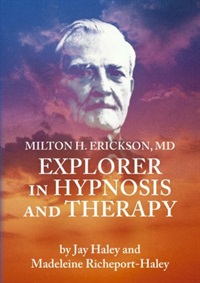
Milton H. Erickson, MD: Explorer in Hypnosis and Therapy - by Jay Haley and Madeline Richeport-Haley
- Average Rating:
- Not yet rated
- Topic Areas:
- Milton Erickson | Hypnosis
- Categories:
- Jay Haley | Erickson Materials | Milton H. Erickson Collections | Biographical Video
- Faculty:
- Milton H. Erickson, MD | Jay Haley, MA
- Duration:
- 1 hour
- Format:
- Audio and Video
- Original Program Date:
- Dec 31, 2005
- Short Description:
- Narrated by Jay Haley, this full color, 60-minute documentary, now available in On Demand and DVD format, offers an intimate and far-reaching portrait of this remarkable individual's life and work. You will learn how Milton Erickson overcame numerous adversities in his early life dyslexia, complete paralysis from polio at age 17, and chronic pain and how these events formed the genesis of his development as an innovator in hypnosis and therapy. Featuring abundant footage of Erickson during interviews and therapeutic sessions, many of which have never been previously released, you will learn more about the man and his work through fascinating interviews with his colleagues, students, patients, and family members. This inspiring portrait of one of the most important therapists of our time will enrich the lives of anyone interested in the extraordinary potential of the human spirit.
- Price:
- $29.95 - Base Price
Tags: Milton Erickson Hypnosis
Credit available - Click Here for more information
- Average Rating:
- Not yet rated
- Topic Areas:
- Trauma | Ericksonian Hypnosis and Therapy Techniques | Milton Erickson | Storytelling | Hypnosis
- Categories:
- Lounsbury Winston Donation | Erickson Materials | Milton H. Erickson Collections | Erickson Streaming Video Collection | Online Continuing Education
- Faculty:
- Milton H. Erickson, MD | Jeffrey Zeig, PhD
- Course Levels:
- Master Degree or Higher in Health-Related Field
- Duration:
- 1 hour
- Format:
- Audio and Video
- Original Program Date:
- Dec 31, 1972
- Short Description:
- For this one-hour video, we reached backed into the Erickson archives, circa 1973 to 1978, to Milton Erickson’s teaching seminars. Erickson conducted these teaching seminars in the comfort and intimacy of his own home. In this video, we encounter three cases – each dealing primarily with trauma. And in each of these cases, there is hidden meaning. Erickson demonstrates how to take “extraneous” information provided by the client, understand the context relevant to the client’s problem, and insightfully extrapolate the true meaning for therapeutic effect.
- Price:
- $19.95 - Base Price
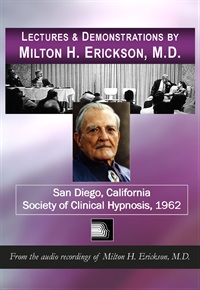
Lectures & Demonstrations of Milton H. Erickson, MD – San Diego - Society of Clinical Hypnosis, 1962
- Average Rating:
- Not yet rated
- Topic Areas:
- Hypnosis | Milton Erickson | Ericksonian Hypnosis and Therapy Techniques | Family Therapy | Pain and Healing | Sex and Sexuality
- Categories:
- Erickson Materials | Lectures & Demonstrations | Milton H. Erickson Collections
- Faculty:
- Milton H. Erickson, MD
- Duration:
- 5:29:03
- Format:
- Audio Only
- Original Program Date:
- Apr 29, 1962
- Short Description:
- Audio recording of Dr. Erickson describing essential differences between traditional hypnosis and modern hypnosis.
- Price:
- $50.00 - Base Price
Please wait ...




